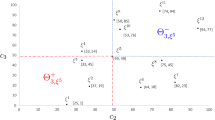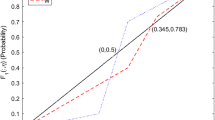Abstract
Second-order stochastic dominance (SSD) is widely recognised as an important decision criterion in portfolio selection. Unfortunately, stochastic dominance models are known to be very demanding from a computational point of view. In this paper we consider two classes of models which use SSD as a choice criterion. The first, proposed by Dentcheva and Ruszczyński (J Bank Finance 30:433–451, 2006), uses a SSD constraint, which can be expressed as integrated chance constraints (ICCs). The second, proposed by Roman et al. (Math Program, Ser B 108:541–569, 2006) uses SSD through a multi-objective formulation with CVaR objectives. Cutting plane representations and algorithms were proposed by Klein Haneveld and Van der Vlerk (Comput Manage Sci 3:245–269, 2006) for ICCs, and by Künzi-Bay and Mayer (Comput Manage Sci 3:3–27, 2006) for CVaR minimization. These concepts are taken into consideration to propose representations and solution methods for the above class of SSD based models. We describe a cutting plane based solution algorithm and outline implementation details. A computational study is presented, which demonstrates the effectiveness and the scale-up properties of the solution algorithm, as applied to the SSD model of Roman et al. (Math Program, Ser B 108:541–569, 2006).
Similar content being viewed by others
References
Dentcheva, D.: Private communication (2006)
Dentcheva D., Ruszczyński A.: Portfolio optimization with stochastic dominance constraints. J. Bank. Finance 30, 433–451 (2006)
Ellison, E.F.D., Hajian, M., Levkovitz, R., Maros, I., Mitra, G.: A Fortran based mathematical programming system FortMP. Brunel University/Uxbridge, NAG Ltd/Oxford (1999)
Fábián, C.I.: Handling CVaR objectives and constraints in two-stage stochastic models. Eur. J. Oper. Res. 191, 888–911 (special issue on continuous optimization in industry. Illés, T., Lopez, M., Vörös, J., Terlaky, T., Weber, G-W. eds.) (2008)
Fábián C.I., Szőke Z.: Solving two-stage stochastic programming problems with level decomposition. Comput. Manage. Sci. 4, 313–353 (2007)
Fábián C.I., Veszprémi A.: Algorithms for handling CVaR-constraints in dynamic stochastic programming models with applications to finance. J. Risk 10, 111–131 (2008)
Fishburn P.C.: Decision and Value Theory. Wiley, New York (1964)
Fishburn P.C.: Utility Theory for Decision Making. Wiley, New York (1970)
Fishburn P.C.: Mean-risk analysis with risk associated with below-target returns. Am. Econ. Rev. 67, 116–126 (1977)
Fourer, R., Gay, D.M., Kernighan, B.: AMPL: a mathematical programming language (1989)
Hadar J., Russell W.: Rules for ordering uncertain prospects. Am. Econ. Rev. 59, 25–34 (1969)
Hardy G.H., Littlewood J.E., Polya G.: Inequalities. Cambridge University Press, Cambridge (1934)
Kall, P., Mayer, J.: Stochastic linear programming: models, theory, and computation. Springer, Int. Ser. Oper. Res. Manage. Sci. (2005)
Klein Haneveld W.K.: Duality in Stochastic Linear and Dynamic Programming. Lecture Notes in Economics and Math. Systems, vol. 274. Springer, New York (1986)
Klein Haneveld, W.K., van der Vlerk, M.H.: Integrated chance constraints: reduced forms and an algorithm. Comput. Manage. Sci. 3, 245–269 (2006), First published as SOM Research Report 02A33, University of Groningen (2002)
Krokhmal P., Palmquist J., Uryasev S.: Portfolio optimization with conditional value-at-risk objective and constraints. J. Risk 4, 11–27 (2002)
Krokhmal, P., Soberanis, P.: Risk optimization with p-order conic constraints: a linear programming approach. Working paper, Department of Mechanical and Industrial Engineering, The University of Iowa, IA 52242 (2008)
Künzi-Bay A., Mayer J.: Computational aspects of minimizing conditional value-at-risk. Comput. Manage. Sci. 3, 3–27 (2006)
Lemaréchal C., Nemirovskii A., Nesterov Yu.: New variants of bundle methods. Math. Program. 69, 111–147 (1995)
Levy H.: Stochastic dominance and expected utility: survety and analysis. Manage. Sci. 38, 555–593 (1992)
Lim, C., Sherali, H.D., Uryasev, S.: Portfolio optimization by minimizing conditional value-at-risk via nondifferentiable optimization. Comput. Optim. Appl. (2008) doi:10.1007/s10589-008-9196-3
Mansini R., Ogryczak W., Speranza M.G.: Conditional value-at-risk and related linear programming models for portfolio optimization. Ann. Oper. Res. 152, 227–256 (2007)
Markowitz H.: Portfolio selection. J. Finance 7, 77–91 (1952)
von Neumann J., Morgenstern O.: Theory of Games and Economic Behavior. Princeton University Press, Princeton (1947)
Ogryczak W.: Multiple criteria linear programming model for portfolio selection. Ann. Oper. Res. 97, 143–162 (2000)
Ogryczak W.: Multiple criteria optimization and decisions under risk. Control Cybern. 31, 975–1003 (2002)
Ogryczak W., Ruszczyński A.: From stochastic dominance to mean-risk models: semideviations as risk measures. Eur. J. Oper. Res. 116, 33–50 (1999)
Ogryczak W., Ruszczyński A.: On consistency of stochastic dominance and mean-semideviations models. Math. Program. 89, 217–232 (2001)
Ogryczak W., Ruszczyński A.: Dual stochastic dominance and related mean-risk models. SIAM J. Optim. 13, 60–78 (2002)
Prékopa, A.: Probabilistic programming. In: Ruszczyński, A., Shapiro, A. (eds.) Stochastic Programming, Handbooks in Operations Research and Management Science, vol. 10, Elsevier: Amsterdam
Quirk J.P., Saposnik R.: Admissibility and measurable utility functions. Rev. Econ. Stud. 29, 140–146 (1962)
Rockafellar R.T.: Convex Analysis. Princeton University Press, Princeton (1970)
Rockafellar, R.T.: Coherent approaches to risk in optimization under uncertainty. Tutorials in Oper. Res. INFORMS, 38–61 (2007)
Rockafellar R.T., Uryasev S.: Optimization of conditional value-at-risk. J. Risk 2, 21–41 (2000)
Rockafellar R.T., Uryasev S.: Conditional value-at-risk for general loss distributions. J. Bank. Finance 26, 1443–1471 (2002)
Roman D., Darby-Dowman K., Mitra G.: Portfolio construction based on stochastic dominance and target return distributions. Math. Program. Ser. B 108, 541–569 (2006)
Roman D., Mitra G., Darby-Dowman K.: Mean-risk models using two risk measures: a multi-objective approach. Quant. Finance 7, 443–458 (2007)
Ross S.M.: An Elementary Introduction to Mathematical Finance. Cambridge University Press, Cambridge (2002)
Ruszczyński A.: A regularized decomposition method for minimizing the sum of polyhedral functions. Math. Program. 35, 309–333 (1986)
Sadki, A.M.: AMPL COM Component Library, User’s Guide Version 1.6. Internal T. Report (2005). See also http://www.optirik-systems.com/products/AMPLCOM
Whitmore G.A.: Third-degree stochastic dominance. Am. Econ. Rev. 60, 457–459 (1970)
Whitmore G.A., Findlay M.C.: Stochastic Dominance: An Approach to Decision-Making Under Risk. D.C.Heath, Lexington, MA (1978)
Wierzbicki A.: A mathematical basis for satisficing decision making. Math. Model. 3, 391–405 (1982)
Yamai Y., Yoshiba T.: Comparative analyses of expected shortfall and value-at-risk: expected utility maximization and tail risk. Monet. Econ. Stud. 20, 57–86 (2002)
Author information
Authors and Affiliations
Corresponding author
Rights and permissions
About this article
Cite this article
Fábián, C.I., Mitra, G. & Roman, D. Processing second-order stochastic dominance models using cutting-plane representations. Math. Program. 130, 33–57 (2011). https://doi.org/10.1007/s10107-009-0326-1
Received:
Accepted:
Published:
Issue Date:
DOI: https://doi.org/10.1007/s10107-009-0326-1




